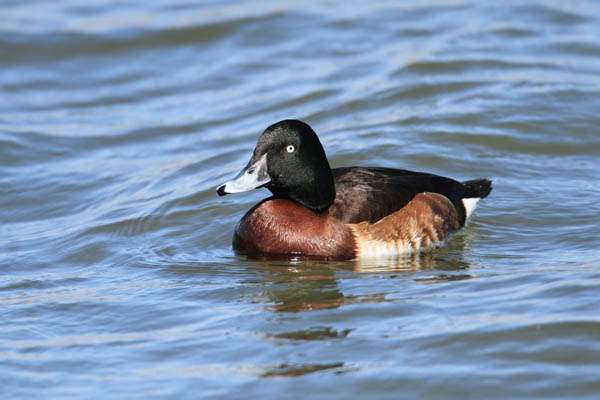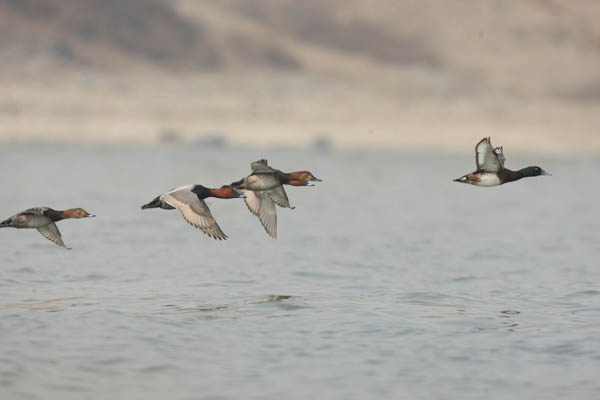Aythya baeri
IUCN
LCBasic Information
Scientific classification
- name:Aythya baeri
- Scientific Name:White-eyed duck, Oriental white-eye duck, Mallard duck,Aythya baeri,Baer's Pochard
- Outline:Waterfowl
- Family:Anseriformes Anatidae Duckling
Vital signs
- length:420-734mm
- Weight:500-730g
- lifetime:6-8years
Feature
It rarely sings and is a deep-water bird that is good at diving by folding its wings.
Distribution and Habitat
In China, it breeds in the northeastern provinces, passes through central and eastern China during migration, and winters in the Yangtze River Basin and areas south of it, including Taiwan Island. Abroad, it breeds in southeastern Siberia and winters in the Korean Peninsula, Japan, East Asia, South Asia, and Southeast Asia.
It breeds in lakes and swamps with many reeds. In the non-breeding season, it lives in ponds, lakes, reservoirs, and rivers with slow water flow, and feeds mostly on aquatic plants. At present, due to the large-scale development of its breeding habitat, the population has decreased sharply.
Appearance
The male has a dark green and shiny head, chestnut brown upper back, neck and prothorax, dark brown upper body, dark brown wings with white wing mirrors, chestnut brown flanks, white undertail coverts, white abdomen and extending to the flanks, alternating with chestnut brown to form inconspicuous white vertical stripes. The female is dark brown all over, with a particularly dark head, a chestnut brown spot at the base of the beak, and white wing mirrors and undertail coverts. The difference from the white-eyed pochard is that the flanks have white serrated stripes. The male has white irises, the female has dark brown irises, gray-black beaks, and lead-gray feet.
Details
The blue-headed duck is a migratory bird. It migrates from the wintering grounds in the south to the north for breeding in mid-March every year; it starts to migrate to the south in mid-October in autumn, and a few migrate as late as early November. During migration, it gathers in small groups of more than 10 or dozens of birds, and the formation is often wedge-shaped. The flight altitude is generally not high, and it mostly flies at low altitude.

In autumn and winter, it also gathers in large groups of dozens or even nearly a hundred birds. Sometimes it also lives in mixed groups with crested ducks or other diving ducks. It is timid, has strong wings, flies very fast, and can also walk quickly on the ground. It is good at diving and swimming, and is also very flexible in taking off from the water. When startled, it can immediately rush out of the water.

The breeding season is from May to July. A few may be as late as early August. It nests in the grass on the ground near the water or in the reeds and cattails in shallow water near the water. The nest is made of hay. Each nest contains 6-9 eggs. The eggs are yellowish or light brown and are 27-40 mm x 50-55 mm in size. The female incubates the eggs. The male leaves the female to molt after the female begins incubating the eggs. The incubation period is 27 days. The chicks are mature and can follow the parents and forage soon after hatching. They can fly after about 150 days of chick life.
The overall population is declining due to excessive hunting and habitat degradation, including the destruction of wetlands where it breeds and overwinter. In some cases, the species has been depleted of water levels or water bodies in areas that were previously important to its habitat (such as the Xianghai Reserve for breeding populations and the Baiquan Wetlands for overwintering populations). The population has become very rare from confirmed hunting reports of high mortality, including reports of 3,000 being shot annually in Rudong County, Jiangsu Province.

Listed in China's "National Key Protected Wildlife List" (February 5, 2021) Level 1.
On May 16, 2022, many critically endangered species and national first-level protected animals, the blue-headed duck, were found in the Saihu Wetland in Ruichang City, Jiangxi Province.
In May 2022, the Hebei Provincial Forestry and Grassland Bureau discovered more than 10 adult blue-headed ducks while monitoring birds in the Baiyangdian Wetland.








